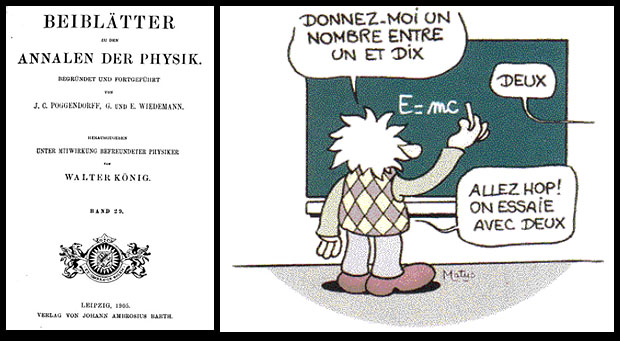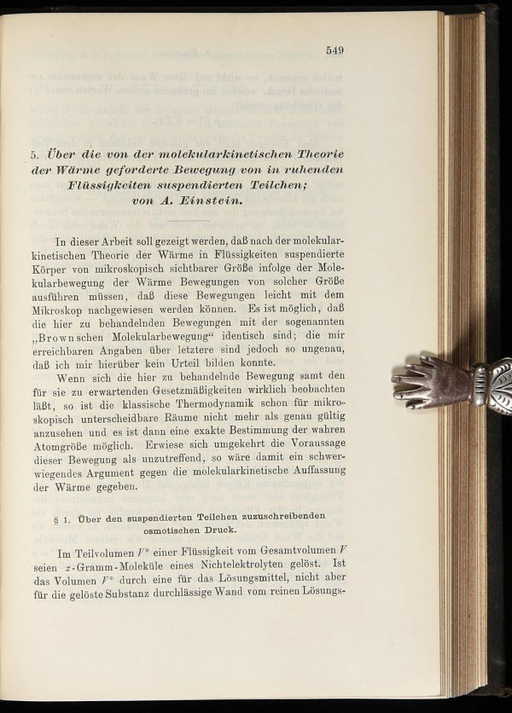| Discipline | Physics |
|---|---|
| Language | English |
| Edited by | Stefan Hildebrandt |
| Publication details | |
| History | 1799–present |
| Publisher | |
| Frequency | Monthly |
| 3.276 (2018) | |
| Standard abbreviations | |
| ISO 4 | Ann. Phys. (Berl.) |
| MathSciNet | Ann. Phys. |
| NLM | Ann Phys |
| Indexing | |
| ISSN | 0003-3804 (print) 1521-3889 (web) |
| LCCN | 50013519 |
| OCLC no. | 5854993 |
| Links | |
Annalen der Physik (English: Annals of Physics) is one of the oldest scientific journals on physics and has been published since 1799. The journal publishes original, peer-reviewed papers in the areas of experimental, theoretical, applied, and mathematical physics and related areas. The current editor-in-chief is Stefan Hildebrandt.[1] Prior to 2008, its ISO 4 abbreviation was Ann. Phys. (Leipzig), and after 2008 Ann. Phys. (Berl.).
In this work, we describe the chronology of Einstein's scientifics discoveries (including his Annus Mirabilis papers) and a full list of his scientist publications. Annalen der Physik, 33. Das Prinzip von der Erhaltung der Schwerpunktsbewegung und die Traegheit der Energie, Einstein, Albert, 1906 Die Grundlage der allgemeinen Relativitaetstheorie, Einstein, Albert, 1916 Die Nordstroemsche Gravitationstheorie vom Standpunkt des absoluten Differentialkalkuels, Einstein, Albert; Fokker, A.
The journal is the successor to Journal der Physik published from 1790 until 1794, and Neues Journal der Physik published from 1795 until 1797.[2] The journal has been published under a variety of names (Annalen der Physik, Annalen der Physik und der physikalischen Chemie, Annalen der Physik und Chemie, Wiedemann's Annalen der Physik und Chemie) during its history.
History[edit]
Originally, Annalen der Physik was published in German, then a leading scientific language. From the 1950s to the 1980s, the journal published in both German and English. Initially, only foreign authors contributed articles in English but from the 1970s German-speaking authors increasingly wrote in English in order to reach an international audience. After the German reunification in 1990, English became the only language of the journal.
The importance of Annalen der Physik unquestionably peaked in 1905 with Albert Einstein's Annus Mirabilis papers. In the 1920s, the journal lost ground to the concurrent Zeitschrift für Physik. With the 1933 emigration wave, German-language journals lost many of their best authors. During Nazi Germany, it was considered to represent 'the more conservative elements within the German physics community', alongside Physikalische Zeitschrift.[3] From 1944–1946 publication was interrupted because of World War II, but resumed in 1947 under Soviet occupation rule. While Zeitschrift für Physik moved to Western Germany, Annalen der Physik served physicists in East Germany. After the German reunification, the journal was acquired by Wiley-VCH.
A relaunch of the journal with new editor and new contents was announced for 2012.[4] As a result of the 2012 relaunch, Annalen der Physik now features a refocused scope, an updated editorial board, and new, more modern cover designs.
Editors[edit]
The early editors-in-chief were:
- Friedrich Albrecht Carl Gren (1790–1797) (as Journal der Physik and Neues Journal der Physik)
- Ludwig Wilhelm Gilbert (1799–1824) (as Annalen der Physik and Annalen der Physik und der physikalischen Chemie)
- Johann Christian Poggendorff (1824–1876) (as Annalen der Physik und Chemie)
- Gustav Heinrich Wiedemann (1877–1899) (as Annalen der Physik und Chemie)
- Paul Karl Ludwig Drude (1900–1906) (as Annalen der Physik)
With each editor, the numbering of volumes restarted from 1 (co-existent with a continuous numbering, a perpetual source of confusion).[2] The journal was often referred to by the editor's name: Gilberts Annalen, Poggendorfs Annalen, Wiedemann's Annalen and so on, or for short Pogg. Ann., Wied. Ann.

After Drude, the work was divided between two editors: experimentalists Wilhelm Wien (1907–1928) and Eduard Grüneisen (1929–1949) and theoretician Max Planck (1907–1943, had been associate editor from 1895).
In these times, peer-review was not yet standard. Einstein, for example, just sent his manuscripts to Planck who then subsequently published them.
Notable published works[edit]
Some of the most famous papers published in Annalen der Physik were:
- on stretched exponential relaxation by Rudolf Kohlrausch (1854) [5][6]
- on stretched exponential relaxation by Friedrich Kohlrausch (1863,1876),[7][8]
- on the photoelectric effect by Heinrich Hertz (1887),[9]
- on the theory of blackbody radiation by Max Planck (1901),[10]
- on capillarity by Albert Einstein (1901),[11]
- the Annus Mirabilis papers by Albert Einstein on photons,[12] on Brownian motion,[13] on mass–energy equivalence,[14] and on the special theory of relativity,[15] (1905)
- on the heat capacities of solids with quantized energy levels by Einstein (1907),[16]
- on molecular motion near absolute zero by Einstein and Otto Stern (1913),[17]
- on the general theory of relativity by Einstein (1916)[18]
Abstracting and indexing[edit]
The journal is abstracted and indexed in:

- Current Contents/Physical, Chemical & Earth Sciences
- Mathematical Reviews/MathSciNet
- Zentralblatt MATH/Mathematics Abstracts
According to the Journal Citation Reports, the journal has a 2015 impact factor of 3.443, ranking it 11th out of 79 journals in the category 'Physics Multidisciplinary'.[19]
See also[edit]
References[edit]
- ^'The Editorial Team of Annalen der Physik'. Annalen der Physik. doi:10.1002/(ISSN)1521-3889. Retrieved 1 March 2017.
- ^ ab'Annalen der Physik - History'. Physik.uni-augsburg.de. 2002-03-26. Retrieved 2012-10-06.
- ^Hentschel, Klaus, ed. (1996). Physics and National Socialism: An anthology of primary sources(PDF). Birkhäuser Verlag. ISBN978-3-0348-9008-3.
- ^Annalen der Physik (announcement). Wiley Online Library. (retrieved 17-aug-2011).
- ^R. Kohlrausch (1854). 'Theorie des elektrischen Rückstandes in der Leidener Flasche'. Annalen der Physik und Chemie. 167 (1): 56–82. Bibcode:1854AnP...167...56K. doi:10.1002/andp.18541670103.
- ^R. Kohlrausch (1854). 'Theorie des elektrischen Rückstandes in der Leidener Flasche'. Annalen der Physik und Chemie. 167 (2): 179–214. Bibcode:1854AnP...167..179K. doi:10.1002/andp.18541670203.
- ^Kohlrausch, F. (1863). 'Ueber die elastische Nachwirkung bei der Torsion'. Annalen der Physik. 195 (7): 337–368. Bibcode:1863AnP...195..337K. doi:10.1002/andp.18631950702.
- ^Kohlrausch, F. (1876). 'Experimental-Untersuchungen über die elastische Nachwirkung bei der Torsion, Ausdehnung und Biegung'. Annalen der Physik. 234 (7): 337–375. Bibcode:1876AnP...234..337K. doi:10.1002/andp.18762340702.
- ^H. Hertz (1887). 'Ueber einen Einfluss des ultravioletten Lichtes auf die electrische Entladung'. Annalen der Physik. 267 (8): 983–1000. Bibcode:1887AnP...267..983H. doi:10.1002/andp.18872670827.
- ^M. Planck (1901). 'Ueber das Gesetz der Energieverteilung im Normalspectrum'(PDF). Annalen der Physik. 309 (3): 553–563. Bibcode:1901AnP...309..553P. doi:10.1002/andp.19013090310.
- ^A. Einstein (1901). 'Folgerungen aus den Capillaritätserscheinungen'(PDF). Annalen der Physik. 309 (3): 513–523. Bibcode:1901AnP...309..513E. doi:10.1002/andp.19013090306.
- ^A. Einstein (1905). 'Über einen die Erzeugung und Verwandlung des Lichtes betreffenden heuristischen Gesichtspunkt'(PDF). Annalen der Physik. 322 (6): 132–148. Bibcode:1905AnP...322..132E. doi:10.1002/andp.19053220607.
- ^A. Einstein (1905). 'Über die von der molekularkinetischen Theorie der Wärme geforderte Bewegung von in ruhenden Flüssigkeiten suspendierten Teilchen'(PDF). Annalen der Physik. 322 (8): 549–560. Bibcode:1905AnP...322..549E. doi:10.1002/andp.19053220806.
- ^A. Einstein (1905). 'Ist die Trägheit eines Körpers von seinem Energieinhalt abhängig?'(PDF). Annalen der Physik. 323 (13): 639–641. Bibcode:1905AnP...323..639E. doi:10.1002/andp.19053231314.
- ^A. Einstein (1905). 'Zur Elektrodynamik bewegter Körper'(PDF). Annalen der Physik. 322 (10): 891–921. Bibcode:1905AnP...322..891E. doi:10.1002/andp.19053221004.
- ^A. Einstein (1906). 'Die Plancksche Theorie der Strahlung und die Theorie der spezifischen Wärme'(PDF). Annalen der Physik. 327 (1): 180–190. Bibcode:1906AnP...327..180E. doi:10.1002/andp.19063270110.
- ^A. Einstein, O. Stern (1913). 'Einige Argumente für die Annahme einer molekularen Agitation beim absoluten Nullpunkt'(PDF). Annalen der Physik. 345 (3): 551–560. Bibcode:1913AnP...345..551E. doi:10.1002/andp.19133450309.
- ^A. Einstein (1916). 'Die Grundlage der allgemeinen Relativitätstheorie'(PDF). Annalen der Physik. 354 (7): 769–822. Bibcode:1916AnP...354..769E. doi:10.1002/andp.19163540702.
- ^'Wiley Online Library - Annalen der Physik'. Wiley.com. doi:10.1002/(ISSN)1521-3889. Retrieved July 28, 2016.Cite journal requires
|journal=(help)
External links[edit]
- Early issues from the 1800s digitized by Gallica

Annalen Der Physik Einstein Pdfcorporationwestern Photoelectric
Einstein's Proposal of the Photon Concept-a Translation of the Annalen der Physik Paper of 1905
Abstract
Annalen Der Physik Einstein Pdfcorporationwestern Gymnasium
Of the trio of famous papers that Albert Einstein sent to the Annalen der Physik in 1905 only the paper proposing the photon concept has been unavailable in English translation. The American Journal of Physics is publishing the following translation in recognition of the sixtieth anniversary of the appearance of the original work. Physics teachers may take particular interest in the following aspects: (1) Einstein's keen awareness of the heuristic character of his new conception. (2) His demonstration from thermodynamic and statistical considerations that electromagnetic radiation might be conceived as consisting of finite numbers of discrete corpuscles of energy hv. (3) His prediction of the linear relation between the stopping potential of photoelectrons and the frequency of the incident light. This latter aspect of the photoelectric effect was not included among Lenard's early investigations. It remained for Millikan and others to develop the elegant experimental techniques that confirmed Einstein's bold prediction. Readers interested in pursuing the background in greater depth will find it rewarding to refer to the critical analyses by Martin J. Klein in 'Einstein's First Paper on Quanta,' in The Natural Philosopher (Blaisdell Publishing Company, New York, 1963), Vol. II, and 'Einstein and the Wave-Particle Duality,' in The Natural Philosopher, Vol. III, 1964. We are grateful to Professor Klein for his criticism and advice regarding this translation and for his generosity in making available to us an unpublished translation of his own.
Annalen Der Physik Einstein Pdfcorporationwestern Lectures
- Publication:
- Pub Date:
- May 1965
- DOI:
- 10.1119/1.1971542
- Bibcode:
- 1965AmJPh..33..367A
